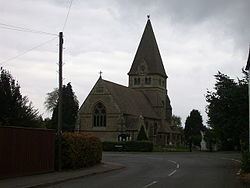OS grid reference TL414912 Postcode district PE15 Local time Monday 9:42 PM | Sovereign state United Kingdom Population 2,211 (2011 Census) | |
 | ||
Weather 11°C, Wind S at 13 km/h, 76% Humidity | ||
Wimblington is a village in Cambridgeshire, England, with a population of 1700 as of the 2001 census, including Stonea and increasing to 2,211 at the 2011 Census.
Contents
Map of Wimblington, March, UK
History
Formerly a hamlet of the large Doddington parish, in 1874 it became a separate parish and a new church, St Peter's, was opened on 15 May of that year. The church was designed by Thomas Henry Wyatt. The village is effectively divided into two; a hamlet known as Eastwood End is separated from the main village by the A141 road, which was previously divided by the St Ives extension of the Great Eastern Railway line between March and Chatteris. Wimblington railway station closed in 1967.
Wimblington won the Cambridgeshire Times and Wisbech Standard "Best Kept Village" award nine times and in 1997 came second in the "National Village of the Year" competition. In 2002 and 2003 Wimblington & Stonea won the Fenland Section of the Calor Village of the Year competition. In 2003 Wimblington & Stonea also won the Cambridgeshire section an achievement which was marked by the presentation of the prestigious Fairhaven Trophy, which was awarded by Lord Fairhaven of Anglesey Abbey. In the same year, Wimblington & Stonea was one of 40 villages throughout England and Wales to be put forward for the Village of the Year final, where the community won the Youth Section for the East of England and the Home Counties.
In 2005 the community worked to raise funds for the refurbishment of the village's beautiful Italian marble War Memorial which can be found within St Peter's churchyard. The re-dedication ceremony took place just before Remembrance Sunday, which was the target date for 2005, the 60th Anniversary of the ending of World War II. As the memorial was refurbished it was agreed within the village and by various organisations, after much consultation the name of Percy Bush Cox should be removed from the War Memorial. Cox was "missing in action believed dead" following World War I, however it was discovered that Percy was still alive in 1950 when he was reunited with his family. Cox was photographed at the War Memorial and pointing at his name along with his father and brother, the photo was released in the local newspapers. Cox took his own life in the 1950s and it was discovered he had been living under another name, Ernest Durham.
Sport in the village
Sport in Wimblington is prominent in comparison to the size of the village. Wimblington boasts a football club which now consists of three teams. The village also has a cricket team and archery is also performed in the village. Wimblington has two sports pitches, of which Parkfield is the main one with space for two football pitches, a cricket pitch, basketball court also used for five a side football, and a pub. The other sports field in Wimblington is solely a football pitch but has a playground for younger members of the community.
The pub in the village is The Anchor and is a central meeting point for all in Wimblington and outsiders are also welcome. The village also had another two pubs, the oldest being the Carpenters Arms which was built in the early 17th century.
Sister towns
Morazzone, Italy (2007)
